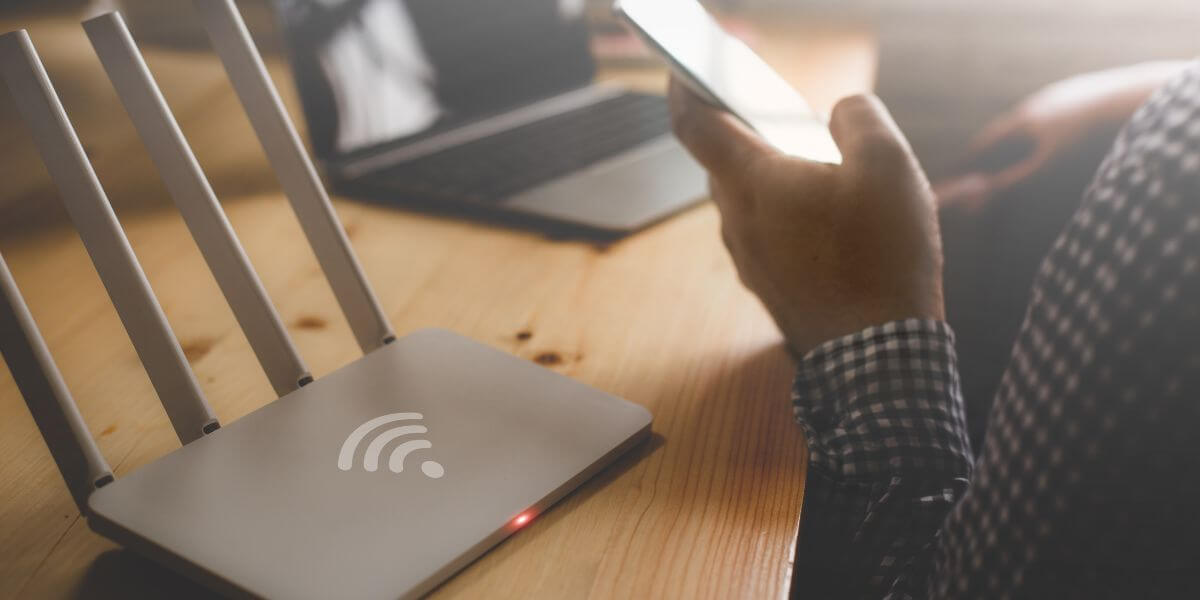Lower your internet bill
61% of people overpay for their internet.
Are you one of them?
Unlock exclusive offers in your area!
Call now
[tel]Enter zip code
1 Star is Poor & 5 Stars is Excellent.
* Required
Written by Sam Watanuki - Pub. Apr 30, 2025 / Updated Apr 29, 2025
Table of Contents
Are you happy with your Internet service?
About the author
Ever wonder why your WiFi is lightning-fast in your living room but barely connects in your home office? The culprit might be hiding in plain sight—your walls.
Different wall materials block WiFi signal with varying intensity, creating those frustrating dead zones throughout your home.
WiFi routers transmit data using radio waves that need to travel through your home to reach your devices [1]. These waves can be absorbed, reflected, or scattered by the materials they encounter along the way. When wall materials block WiFi signal, your connection suffers from reduced speed, intermittent connectivity, or complete signal loss.
Figuring out which wall materials interfere the most with your signal can help you place your router better or find ways to boost your Wi-Fi where you need it most.

The worst offenders
When it comes to blocking WiFi signal, some wall materials are worse than others. These materials either reflect or absorb the radio waves that carry your Wi-Fi signal, causing significant interference. Here are some of the most common culprits:
Metal is the ultimate WiFi signal killer. As a conductor of electricity, metal absorbs and reflects electromagnetic waves, making it extremely difficult for WiFi signals to penetrate [2]. Common metal-containing barriers in homes include:
If you live in a modern building with metal framing or a home with extensive metal elements, your WiFi signal may struggle to maintain strength throughout the space.
Concrete, especially thick or reinforced concrete, creates significant WiFi signal loss. If you live in an apartment building or home with concrete walls, you’ve likely experienced this firsthand.
The density of concrete blocks WiFi signals effectively, with 8-inch (203mm) concrete walls causing up to 55 decibels of signal attenuation [3]. This makes concrete one of the most challenging materials for WiFi to penetrate.
Basement walls are particularly problematic as they’re often made of thick concrete that can be double the width of standard interior walls.
Brick walls present another significant barrier for WiFi signals. Classic brick construction consists of dense clay material that absorbs radio waves. The mortar between bricks adds another layer of signal-blocking material.
Older homes with solid brick walls often struggle with whole-home WiFi coverage. Brick veneer—a thin layer of brick over standard framing—causes less interference than solid brick walls but still impedes signals more than drywall [4].
Stone walls, common in historic homes and some modern designs, create substantial WiFi barriers. Natural stone is dense and often contains minerals that can absorb and reflect signals. The thicker the stone wall, the greater the signal loss.
If your home features stone walls, you’ll likely need multiple access points to ensure adequate coverage throughout the space.
While regular plaster walls cause minimal signal loss, plaster over metal lath backing creates a significant WiFi barrier. This construction method, common in older homes, embeds a metal mesh within the wall structure, creating a barrier similar to a metal screen.
The combination of the plaster’s density and the metal mesh’s reflective properties makes these walls particularly challenging for WiFi signals to penetrate.
Moderate offenders in terms of blocking WiFi signals include materials such as glass, water, and ceramics. While these materials do not create a complete barrier like concrete or metal lath, they can still cause significant signal loss.
Windows seem transparent to WiFi signals, but modern energy-efficient windows often contain metal oxide coatings that can block or reflect wireless signals [5]. Low-E (low emissivity) glass, while excellent for energy conservation, can reduce WiFi transmission.
Large mirrors cause similar issues due to their metal backing, which reflects both light and WiFi signals. If your router is positioned near large mirrors or windows with energy-efficient coatings, your signal may not travel as expected.
Water absorbs WiFi signals surprisingly well [6]. Large aquariums, water pipes, and even the water in human bodies can reduce signal strength. Bathrooms with tile-covered walls and water pipes often experience weaker signals, as do areas near large fish tanks or water features.
Ceramic tile itself doesn’t significantly block WiFi, but the backing materials and installation methods can create problems. Tile installed over cement board or metal lath will impede signals more than tile installed over drywall. Bathrooms and kitchens often combine tile with metal plumbing, creating zones of reduced signal strength.

Low-impact materials
Finally, there are some materials that have minimal impact on WiFi signals. While they may slightly reduce signal strength, the effects are typically negligible and unlikely to cause any major issues.
Standard drywall walls have minimal impact on WiFi signals. These walls, made of gypsum panels with paper facing, allow signals to pass through with very little attenuation. However, if the drywall contains foil-backed insulation or metal studs, signal loss increases significantly.
Wood is relatively transparent to WiFi signals. Wooden walls, doors, and furniture cause minimal interference, making them ideal materials in areas where maintaining strong WiFi is important. According to testing, wooden materials cause only about 5-12 decibels of signal loss, which is barely noticeable in most situations (7).
WiFi signal strength is measured in decibel-milliwatts (dBm), with values typically ranging from -30 dBm (excellent signal) to -90 dBm (extremely weak signal). Each 3 dBm drop represents approximately half the signal strength. Here’s what different signal strength measurements mean for your connection:
You can measure your home’s signal strength using WiFi analyzer apps available for smartphones and computers. Testing the signal throughout your home helps identify problem areas affected by signal-blocking materials.
The simplest solution to improve your signal is often repositioning your router. Place your router:
Mesh networks use multiple access points to create a blanket of coverage throughout your home. These systems are ideal for homes with signal-blocking wall materials, as they can position access points strategically to work around barriers. Unlike basic extenders, mesh systems provide seamless connectivity as you move through your home, automatically connecting your devices to the strongest access point.
WiFi extenders can boost your signal in areas with poor coverage. Place extenders in locations with moderate signal strength to maximize their effectiveness. While not as seamless as mesh systems, extenders offer a more affordable solution for homes with problematic wall materials.
Routers operate on multiple frequency bands. The 5GHz band often provides faster speeds but is more susceptible to blockage by wall materials. The 2.4GHz band offers better penetration through walls but slower speeds.
A dual-band or tri-band router gives you flexibility to use the most appropriate frequency for different areas of your home.
For areas separated by extremely signal-blocking materials, consider using Ethernet cables or MoCA (Multimedia over Coax Alliance) adapters that use existing coaxial cable lines to extend your network. Powerline adapters that transmit internet signals through electrical wiring can also bypass problematic walls.

Get expert help
If you’ve tried the above solutions and still struggle with poor WiFi in certain areas, consider consulting a professional. Networking specialists can:
Different internet providers offer various equipment and solutions for homes with challenging wall materials. Some providers include mesh WiFi systems with their service, while others offer professional installation and optimization.
Wall materials have a significant impact on your WiFi performance, but with proper planning and the right equipment, you can overcome these obstacles. By understanding which materials in your home are causing signal problems, you can implement targeted solutions for reliable connectivity throughout your space.
Remember that multiple factors affect WiFi performance beyond wall materials, including distance from the router, interference from other devices, and the capabilities of your networking equipment. An in-depth approach addressing all these factors will get you the best results for your home network.
[1] Britannica. “How Does Wi-Fi Work?"
[2] Entrepreneur. “12 Surprising Office Wi-Fi Killers."
[3] ResearchGate. “WiFi Signal Strength Degradation Over Different Building Materials."
[4] BrickmyWalls. “Brick Veneer Vs Solid Brick: Comparing Costs, Installation & Benefits."
[5] U.S. Department of Energy. “Window Types and Technologies."
[6] Reddit. “How does water effect wireless signals?"
[7] Wilson Amplifiers. “11 Building Materials That Block Cell Phone Signal."
About the author
Congratulations, you qualify for deals on internet plans.
Speak with our specialists to access all local discounts and limited time offers in your area.
[tel]61% of people overpay for their internet.
Are you one of them?
Unlock exclusive offers in your area!
Call now
[tel]Enter zip code